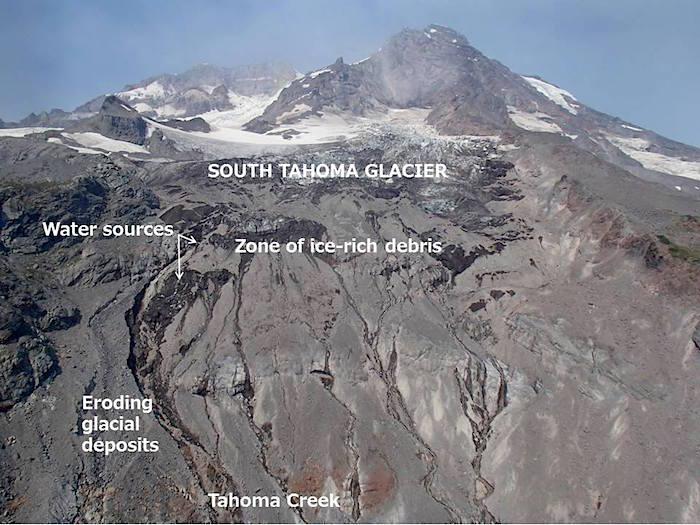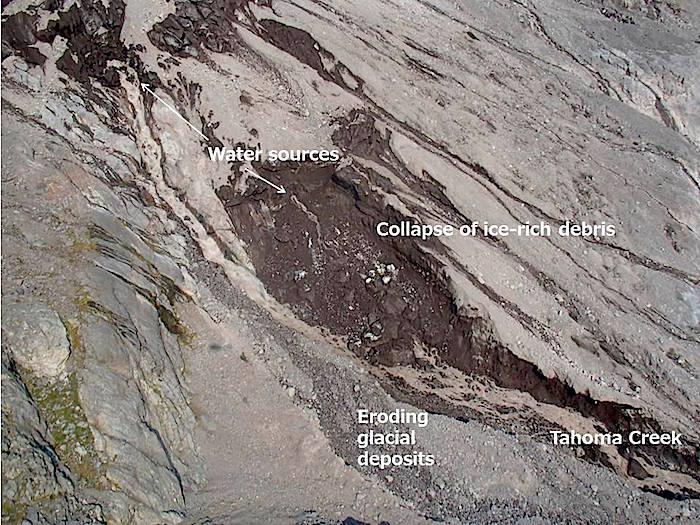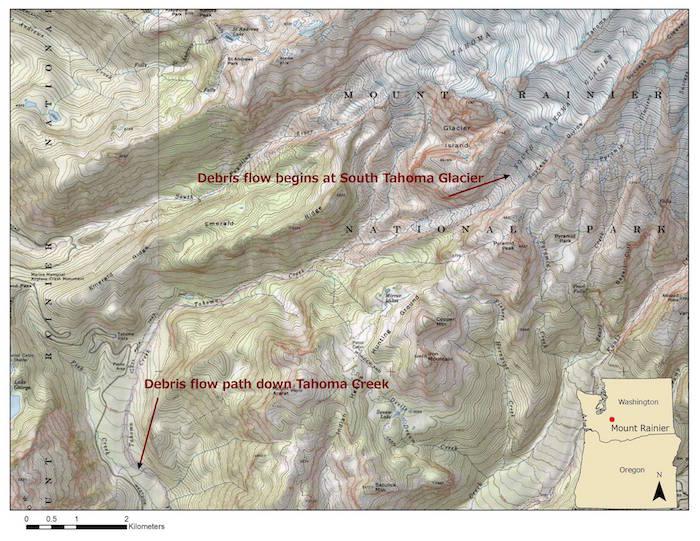Editor's note: This story is being updated to add photos of the incident.

Mount Rainier National Park officials provided this illustrated photo to show where a glacial outburst occurred on Thursday/NPS
The dynamism of glaciers came to life at Mount Rainier National Park when a half-acre portion of the South Tahoma Glacier broke off and spawned a glacial outburst that flooded Tahoma Creek.
The event Thursday morning sent a flood of water and debris downstream, but officials don't think any visitors were harmed by the event. The outburst flood was first reported by a park volunteer who was working near Tahoma Creek on an unrelated research project.
"The volunteer heard a loud roaring sound, followed by the sounds of water moving boulders and the cracks of breaking trees," said Kathy Steichen, the park's chief of interpretation. "As the debris flow from the initial outburst crossed the Westside Road, the volunteer hiked to higher ground. Another volunteer at Indian Henry’s Hunting Ground also heard the loud roar coming from the direction of the South Tahoma Glacier and hiked to a safe location near the suspension bridge over Tahoma Creek to report on subsequent outburst surges."
So forceful were the debris flows that they were picked up by seismic monitoring equipment at Emerald Ridge in the park at 9:40 a.m., 10:30 a.m., 11:30 a.m. and 12:40 p.m. The largest event was recorded at 11:30 am and generated a debris flow that reached the Westside Road at approximately 12 p.m.
"Mount Rainier Park rangers and geologists responded quickly, contacting park visitors in the area and assisting them across the area impacted by the debris flow," the chief of interpretation said. "A Hughes MD530 helicopter from Northwest Helicopters assisted the park with two reconnaissance flights to look for park visitors hiking in the area, check the condition of the trail for possible washouts, and check the South Tahoma Glacier for possible additional outburst geologic hazards. All of the park visitors in the area were accounted for by Thursday evening, but park staff will continue to monitor visitor use in the area."
Some damage to Mount Rainier’s Westside Road was reported on Thursday. The Westside Road will be closed at least through the weekend as the park continues to monitor Tahoma Creek and assess damage to the road and area trails.
“This most recent glacial outburst and debris flow demonstrates again that Mount Rainier is a dynamic landscape,” said Mount Rainier Superintendent Randy King. “Visitors should be aware of their surroundings when traveling in the park. Remember to remain alert for changes in water levels, unusual sounds or shaking of the ground. If you are near a river or stream, move quickly to higher ground.”
 Closeup of one area of the glacial outburst at Mount Rainier National Park/NPS
Closeup of one area of the glacial outburst at Mount Rainier National Park/NPSAbout seven waves of debris flow occurred on Thursday afternoon and evening. As the outburst flood moved down valley, it carried sediment, rocks, and uprooted trees and deposited the debris within the Tahoma Creek valley near Mount Wow in the park, according to staff. A stream gage on the Nisqually River at National registered the 0.5 foot river rise on Thursday afternoon. The debris flow had no impact to properties outside of Mount Rainier National Park.
A glacial outburst flood is a large, abrupt release of water from a glacier. The exact mechanisms through which water moves through glaciers and how these events occur are not well known. Geologists report that stagnant and slow moving ice on the lower part of the glacier combined with faster moving ice on the upper glacier, have been associated with these events in the past.
Since 1985, over 30 debris flows have occurred in the Tahoma Creek valley. Glacial outburst floods from the South Tahoma Glacier during hot, dry weather caused most of the debris flows, but heavy rainstorms in the fall caused several others.
Park visitors who have additional information about the debris flow or photographs are asked to contact Scott Beason, Park Geologist, at [email protected] or 360-569-6781.
For information about visiting Mount Rainier National Park, visit nps.gov/mora or follow us on Facebook at www.facebook.com/MountRainierNPS or Twitter at twitter.com/MountRainierNPS.




Comments
Cool dang
Hiker video of outburst flood (~ 2 min):
http://www.seattletimes.com/seattle-news/science/rainier-melting-unleashes-glacial-outbursts-of-debris/
The Westside Road has reopened three miles to Dry Creek for vehicles, and beyond for bikes and hikers. Here's an interesting account of the flooding by a volunteer who was first on the scene:
http://rainiervolunteers.blogspot.com/2015/08/not-just-another-day-at-of...